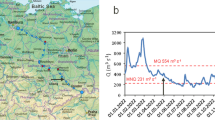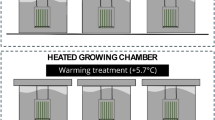Abstract
Short-term growth dynamics of diatoms were examined by daily sampling and microcosm experiments under in situ environmental conditions in the late rainy season (July) for 10 days and by weekly sampling during summer (June–September) at a fixed point in the Yatsushiro Sea, Japan. During the daily sampling period, a bloom of diatoms such as Skeletonema spp., Thalassiosira spp., and Chaetoceros spp. (>104 cells mL−1) occurred in the surface and subsurface layers during the first half of the period, but the population of diatoms declined and sank to the bottom by an average of about 1 m day−1 during the second half of the observation period. Daily changes in net growth rates of the three dominant diatom genera (ranging from −3.8 to 3.0 day−1), which were estimated by daily 24-h microcosm incubations, roughly corresponded with those in ambient cell densities in the surface layer. The relationship between net growth rates and environmental factors suggest that the growth dynamics of diatoms were regulated by irradiance and river discharge (i.e., salinity and phosphate concentration) during the observation period. The field observations using daily microcosm experiments revealed that the maintenance and decline of a diatom bloom on a daily/weekly time scale are controlled by the rapid growth and sinking responses of diatoms following abrupt changes in coastal environments in the Yatsushiro Sea.










Similar content being viewed by others
References
Benincà E, Huisman J, Heerkloss R, Jöhnk KD, Branco P, Van Nes EH, Scheffer M, Ellner SP (2008) Chaos in a long-term experiment with a plankton community. Nature 451:822–825
Bienfang PK, Harrison PJ (1984) Sinking-rate response of natural assemblages of temperate and subtropical phytoplankton to nutrient depletion. Mar Biol 83:293–300
Bienfang PK, Harrison PJ, Quarmby LM (1982) Sinking rate response to depletion of nitrate, phosphate and silicate in four marine diatoms. Mar Biol 67:295–302
Blauw AN, Benincà E, Laane RWPM, Greenwood N, Huisman J (2012) Dancing with the tides: fluctuations of coastal phytoplankton orchestrated by different oscillatory modes of the tidal cycle. PLoS One 7:e49319
Buyukates Y, Roelke D (2005) Influence of pulsed inflows and nutrient loading on zooplankton and phytoplankton community structure and biomass in microcosm experiments using estuarine assemblages. Hydrobiologia 548:233–249
Carter CM, Ross AH, Schiel DR, Howard-Williams C, Hayden B (2005) In situ microcosm experiments on the influence of nitrate and light on phytoplankton community composition. J Exp Mar Biol Ecol 326:1–13
Cloern JE, Dufford R (2005) Phytoplankton community ecology: principles applied in San Francisco Bay. Mar Ecol Prog Ser 285:11–28
Culver ME, Smith WO (1989) Effects of environmental variation on sinking rates of marine phytoplankton. J Phycol 25:262–270
Ding YH, Chan JCL (2005) The East Asian summer monsoon: an overview. Meteorol Atmos Phys 89:117–142
Dugdale RC (1967) Nutrient limitation in the sea: dynamics, identification, and significance. Limnol Oceanogr 12:685–695
Eppley RW, Renger EH (1974) Nitrogen assimilation of an oceanic diatom in nitrogen limited continuous culture. J Phycol 10:15–23
Eppley RW, Rogers JN, McCarthy JJ (1969) Half-saturation constants for uptake of nitrate and ammonium by marine phytoplankton. Limnol Oceanogr 14:912–920
Fisheries Agency (2014) Information on the occurrence of red tide in Kyushu area. Kyushu Fisheries Coordination Office, Annual Report 2013, Fukuoka (in Japanese)
Furnas MJ (1990) In situ growth rates of marine phytoplankton: approaches to measurement, community and species growth rates. J Plankton Res 12:1117–1151
Furuya K, Takahashi M, Nemoto T (1986) Summer phytoplankton community structure and growth in a regional upwelling area off Hachijo Island, Japan. J Exp Mar Biol Ecol 96:43–55
Hallegraeff GM, Reid DD (1986) Phytoplankton species successions and their hydrological environment at a coastal station off Sydney. Aust J Mar Freshwater Res 37:361–377
Hirota R, Hara M (1975) Zooplankton investigations in Yatsushiro-kai, western Kyushu, I: regional and seasonal occurrences of the important zooplankton. J Oceanogr Soc Jpn 31:115–123
Huisman J, Weissing FJ (1999) Biodiversity of plankton by species oscillations and chaos. Nature 402:407–410
Huovinen PS, Brett MT, Goldman CR (1999) Temporal and vertical dynamics of phytoplankton net growth in Castle Lake, California. J Plankton Res 21:373–385
Iriarte JL, Pantoja S, González HE, Silva G, Paves H, Labbé P, Rebolledo L, Ardelan MV, Häussermann V (2013) Assessing the micro-phytoplankton response to nitrate in Comau Fjord (42°S) in Patagonia (Chile), using a microcosms approach. Environ Monit Assess 185:5055–5070
Itakura S, Imai I, Itoh K (1997) “Seed bank” of coastal planktonic diatoms in bottom sediments of Hiroshima Bay, Seto Inland Sea, Japan. Mar Biol 128:497–508
Kivi K, Kaitala S, Kuosa H, Kuparinen J, Leskinen E, Lignell R, Marcussen B, Tamminen T (1993) Nutrient limitation and grazing control of the Baltic plankton community during annual succession. Limnol Oceanogr 38:893–905
Litaker WC, Duke S, Kenny BE, Ramus J (1987) Short-term environmental variability and phytoplankton abundance in a shallow tidal estuary I. Winter and summer. Mar Biol 96:115–121
Lü J-M, Ju J-H, Tao S-Y (2013) Re-discussion on East Asian Meiyu rainy season. Atmos Ocean Sci Lett 6:279–283
Murata K, Sakurada K (2009) The growth environment and reaction to Cochlodinium polykrikoides red tides in the Yatsushiro Sea. Bull Plankton Soc Jpn 56:52–55 (in Japanese with English abstract)
Nagasoe S, Shimasaki Y, Matsubara T, Shikata T, Yamasaki Y, Yoshida Y, Kuno K, Oshima Y, Honjo T (2009) Relationship between physicochemical factors and the growth of phytoplankton at Shiota River estuary in the innermost part of the Ariake Sea, Japan. Bull Coast Oceanogr 46:141–151 (in Japanese with English abstract)
Nakane T, Nakata K, Bouman H, Platt T (2008) Environmental control of short-term variation in the plankton community of inner Tokyo Bay, Japan. Estuar Coast Shelf Sci 78:796–810
Onitsuka G, Aoki K, Shimizu M (2015) Meteorological conditions preceding Chattonella bloom events in the Yatsushiro Sea, Japan, and possible links with the East Asian monsoon. Fish Sci 81:123–130
Orita K, Nishi H, Tahara Y, Nakamura A (2013) Extraction factors involved in Chattonella red tide occurrence in Yatsushiro Sea using statistical methods and possibility of prediction. Bull Kagoshima Pref Fish Tech Dev Cent 4:24–32 (in Japanese)
Örnólfsdóttir EB, Lurnsden SE, Pinckney JL (2004) Nutrient pulsing as a regulator of phytoplankton abundance and community composition in Galveston Bay, Texas. J Exp Mar Biol Ecol 303:197–220
Paasche E (1973) Silicon and the ecology of marine plankton diatoms. II. Silicate-uptake kinetics in five diatom species. Mar Biol 19:262–269
Pace ML, Funke E (1991) Regulation of planktonic microbial communities by nutrients and herbivores. Ecology 72:904–914
Passow U (1991) Species-specific sedimentation and sinking velocities of diatoms. Mar Biol 108:449–455
Perry MJ (1976) Phosphate utilization by an oceanic diatom in phosphorus-limited chemostat culture and in the oligotrophic waters of the central North Pacific. Limnol Oceanogr 21:88–107
Sakurada K, Kino S, Oyama N, Itoyama R (2007) The occurrence situation of harmful plankton in Yatsushiro Sea and a trial of prediction of blooming. Rep Kumamoto Pref Fish Res Cent 7:31–44 (in Japanese)
Shikata T, Nagasoe S, Matsubara T, Yoshikawa S, Yamasaki Y, Shimasaki Y, Oshima Y, Jenkinson IR, Honjo T (2008) Factors influencing the initiation of blooms of the raphidophyte Heterosigma akashiwo and the diatom Skeletonema costatum in a port in Japan. Limnol Oceanogr 53:2503–2518
Shikata T, Sakurada K, Jomoto Y, Onji M, Yoshida M, Ohwada K (2010) Effects of temperature, salinity and light irradiance on phytoplankton growth in the Yatsushiro Sea. Nippon Suisan Gakk 76:34–45 (in Japanese with English abstract)
Sipura J, Lores E, Snyder RA (2003) Effect of copepods on estuarine microbial plankton in short-term microcosms. Aquat Microb Ecol 33:181–190
Smayda TJ (1971) Normal and accelerated sinking of phytoplankton in the sea. Mar Geol 11:105–122
Smayda TJ (1973) The growth of Skeletonema costatum during a winter-spring bloom in Narragansett Bay, Rhode Island. Norweg J Bot 20:219–247
Sommer U (1985) Comparison between steady state and non-steady state competition: experiments with natural phytoplankton. Limnol Oceanogr 30:335–346
Sommer U (1988) Phytoplankton succession in microcosm experiments under simultaneous grazing pressure and resource limitation. Limnol Oceanogr 33:1037–1054
Strom SL, Macri EL, Olson MB (2007) Microzooplankton grazing in the coastal Gulf of Alaska: variations in top-down control of phytoplankton. Limnol Oceanogr 52:1480–1494
Takikawa K, Tanaka K, Mori E, Watanabe K, Hokamura T, Aoyama C (2004) Factorial analysis of environmental variables over Yatsushiro-Sea. Annu J Coast Eng JSCE 51:916–920 (in Japanese with English abstract)
Tarutani K, Yamamoto T (1994) Phosphate uptake and growth kinetics of Skeletonema costatum isolated from Hiroshima Bay. J Fac Appl Biol Sci 33:59–64 (in Japanese with English abstract)
Thomas WH, Dodson AN (1968) Effects of phosphate concentration on cell division rates and yield of a tropical oceanic diatom. Biol Bull 134:199–208
Thomas WH, Dodson AN (1975) On silicic acid limitation of diatoms in near-surface waters of the eastern tropical Pacific Ocean. Deep Sea Res 22:671–677
Tomaru Y, Fujii N, Oda S, Toyoda K, Nagasaki K (2011) Dynamics of diatom viruses on the western coast of Japan. Aquat Microb Ecol 63:223–230
Tsuruta A, Ueno S, Ohgai M, Yamada M (1986) Study on the seasonal and horizontal distributions of phytoplankton communities in Yatsushiro Sea, using a cluster analysis. Nippon Suisan Gakk 52:1947–1955 (in Japanese with English abstract)
Venrick EL, Beers JR, Heinbokel JF (1977) Possible consequences of containing microplankton for physiological rate measurements. J Exp Mar Biol Ecol 26:55–76
Waite A, Bienfang PK, Harrison PJ (1992) Spring bloom sedimentation in a subarctic ecosystem I. Nutrient sensitivity. Mar Biol 114:119–129
Wetz MS, Hales B, Chase Z, Wheeler PA, Whitney MM (2006) Riverine input of macronutrients, iron, and organic matter to the coastal ocean off Oregon, USA, during the winter. Limnol Oceanogr 51:2221–2231
Yamada M, Ueda N, Hamada K (2011) Changes in red tide occurrence and organisms responsible for declining eutrophic level in hyper-eutrophic Dokai Bay, Japan. Nippon Suisan Gakk 77:647–655 (in Japanese with English abstract)
Yamasaki Y, Ohmichi Y, Shikata T, Hirose M, Shimasaki Y, Oshima Y, Honjo T (2010) Species-specific allelopathic effects of the diatom Skeletonema costatum. Thalassas 27:21–32
Yoshida M, Adachi M, Nishida T, Nagata T, Iwatake Y, Kino S, Sakurada K, Ohwada K (2007) Seasonal distribution of phytoplankton in Yatsushiro Sea in 2004 and 2005. Rep Kumamoto Pref Fish Res Cent 7:45–51 (in Japanese)
Yoshida M, Nagata T, Iwatake Y, Kawano Y, Onji M, Sakurada K, Ohwada K (2008) Short term changes of phytoplankton composition in Yatsushiro Sea in summer season. Rep Kumamoto Pref Fish Res Cent 8:27–33 (in Japanese)
Acknowledgments
The authors thank Manabu Shimizu, Masashi Kodama, Katsuyuki Abo, Yukihiko Matsuyama, Katsunori Kimoto, and the staffs of Himedo Fishery Cooperative Association and Kumamoto Prefecture for their cooperation in conducting the field observation. The research was supported by grants from the Fisheries Research Agency of Japan and JSPS KAKENHI grant number 26450253.
Author information
Authors and Affiliations
Corresponding author
Rights and permissions
About this article
Cite this article
Onitsuka, G., Shikata, T., Kitatsuji, S. et al. Factors influencing maintenance and decline of a diatom bloom in the Yatsushiro Sea, Japan. J Oceanogr 72, 617–627 (2016). https://doi.org/10.1007/s10872-016-0358-0
Received:
Revised:
Accepted:
Published:
Issue Date:
DOI: https://doi.org/10.1007/s10872-016-0358-0




